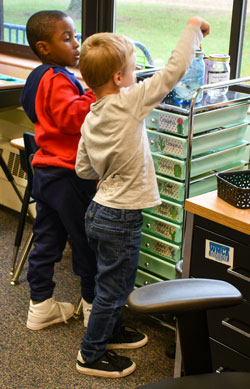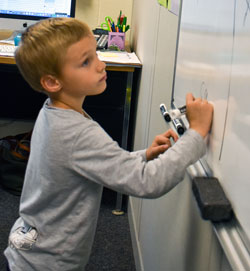On any given day at East Kelloggsville Elementary, you’ll find teacher Jacky Hamann and a handful of students hard at work. Eleven students split their time between the traditional classroom and Hamann’s classroom. With Hamann, they do the same work their classmates are doing, but in a space dedicated to helping them cope with behavioral challenges.
Last week, second grader Eva Cavazos took a break from her math work, modeling two step word problems, to play with “silly monster”, a finger puppet reward she chose for a job well done. Eva is not shy about telling you why she’s come to SWAS.
“I’m here to do work,” she said.
Hamann’s classroom is known as a “school within a school” or “SWAS”, and for students like Cavazos and her SWAS peers, it’s been key to staying productive — and staying in school.

Suspending the Suspensions
The concept is simple: students struggling with behavior leave their classroom and work in SWAS, just down the hall. Some go at regularly-scheduled intervals — from 15 minutes to a half day — as determined by the classroom teacher and Hamann. Others drop in as needed, to cool down and refocus. The extra attention from Hamann, who is trained in emotional and cognitive impairments and learning disabilities, has proven effective. Just ask Anastasia Taggart, whose son Cardier Rogers was in the building’s SWAS room as a third-grader last spring.
Prior to the SWAS program, Taggart had been called so frequently to pick up Cardier from school that she lost her job.
“We had to try something because he was getting kicked out of school all the time,” said Taggart.
Cardier was among the building’s first SWAS students when it started in the spring of 2018. It was a rough start, said Taggart, as students with behavioral challenges converged in one space. But the district worked with Taggart and Cardier to identify challenges, implement a 504 plan and strategically time his SWAS visits for the most impact — like during math, which had been a struggle for Cardier. He thought some of his classmates made fun of him for that reason.

In SWAS, Cardier’s suspensions plummeted. Math became his favorite subject.
“I made the right choices. It’s helped me to be here…and I got better at math,” he said. “It’s fun in here. I get to do a lot of math and now I know division and multiplication.”
One year after Cardier started SWAS, Taggart said she was able to go to her job without fearing the dreaded phone call from the office.
“Sending a kid home, especially at this age, does nothing – studies have shown suspensions really don’t do much good,” said Hamann. “It’s better to have them here, having conversations. Behavior is not a road you take alone. We are a team – I work with our behavior specialist, the classroom teacher, the principal, and the parents.”

A Careful Process
Implementing SWAS is methodical. Before opening her classroom to students, Hamann spends a few weeks observing classrooms, gathering data, and determining which students can most benefit from her classroom.
“They identify themselves fairly quickly,” said Hamann, who shares her observations with classroom teachers. “Their behaviors are crying out for help in some way. It’s our job to figure out how.”
Students can exit SWAS as maturity increases and behaviors improve.
“This is a chance to remove them from where they’re being escalated and give them a chance to get their work done, get a break from classroom triggers, and keep them here at school,” said Beth Travis, who implemented the SWAS room as principal at East Kelloggsville. (Travis helped roll out the middle school SWAS program as assistant principal there, and has returned to the middle school as principal this year.)
Besides East Kelloggsville, SWAS rooms exist at Southeast Elementary and Kelloggsville Middle School.











